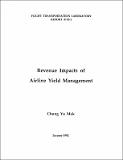Revenue impacts of airline yield management
Author(s)
Mak, Chung Yu
DownloadFTL_R_1992_01.pdf (6.063Mb)
Other Contributors
Massachusetts Institute of Technology. Flight Transportation Laboratory
Metadata
Show full item recordAbstract
In the highly competitive airline industry today, Yield or Revenue Management is extremely important to the survival of any carrier. Since fares are generally matched by all carriers to be competitive, the ability of an airline to control its passenger mix and achieve higher overall revenue is essential. Therefore, the revenue impacts of airline yield management are very important. Although there has been much discussion among people in the industry about the revenue impacts of yield management, it has received little research attention. The focus of this research is to develop an understanding of the revenue impacts of several factors that contribute to the effectiveness of yield management. In this thesis we begin by discussing the issues involved with airline yield management and the existing relevant literature. Based on the knowledge and experience gained through these previous studies, we develop a method to study the revenue impacts of airline yield management. With the development of a single-leg booking simulation, we can isolate most of the external and indirect factors that influence an airline's overall revenue. We perform a number of simulations under different scenarios to estimate the real revenue impacts of airline yield management. The different scenarios tested include varying the number of fare classes, relaxing the demand distribution assumptions, comparing static vs. dynamic seat allocation, relaxing seat inventory control assumptions and incorporating different capacity constraints or demand factors. We then present and discuss the results from these simulations with respect to their revenue impacts. Finally, we use the Revenue Opportunity Model developed by American Airlines Decision Technologies to compare revenue opportunity achieved in a simulated environment, and suggest areas for future research.
Description
January 1991 Also issued as an M.S. thesis, Dept. of Civil Engineering, MIT, 1992 Includes bibliographical references
Date issued
1992Publisher
[Cambridge, Mass. : Massachusetts Institute of Technology, Dept. of Aeronautics & Astronautics, Flight Transportation Laboratory, 1992]
Other identifiers
45656684
Series/Report no.
FTL report (Massachusetts Institute of Technology. Flight Transportation Laboratory) ; R92-1
Keywords
Airlines, Aeronautics, Commercial, Rates, Mathematical models, Passenger traffic